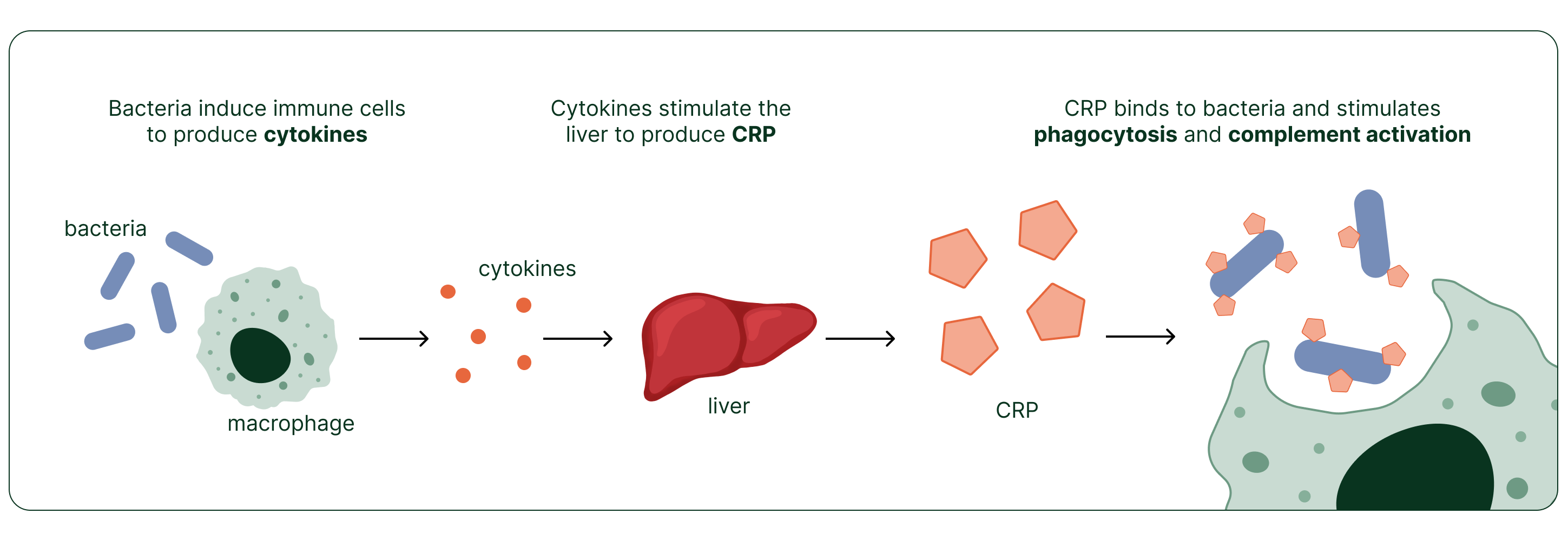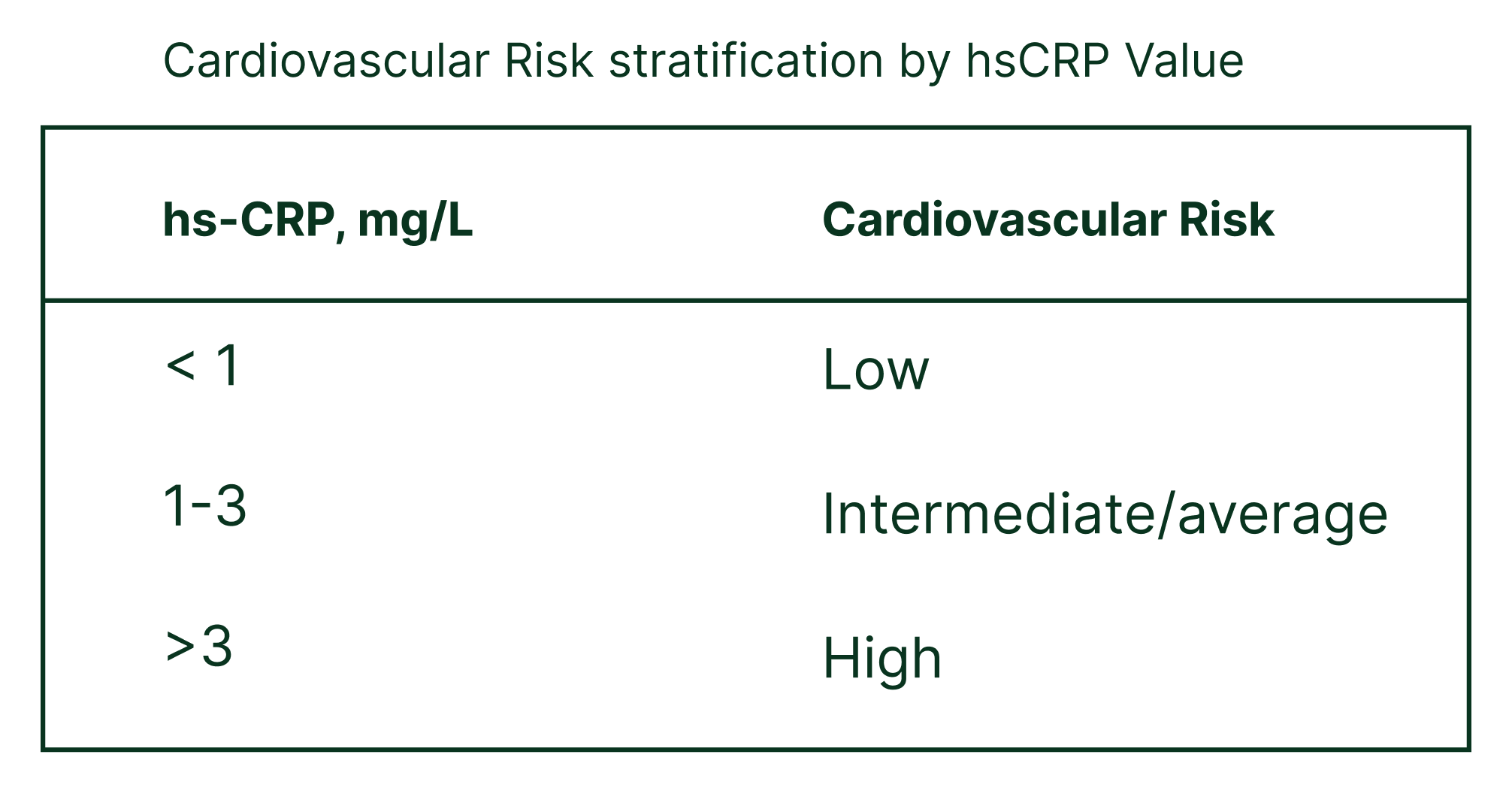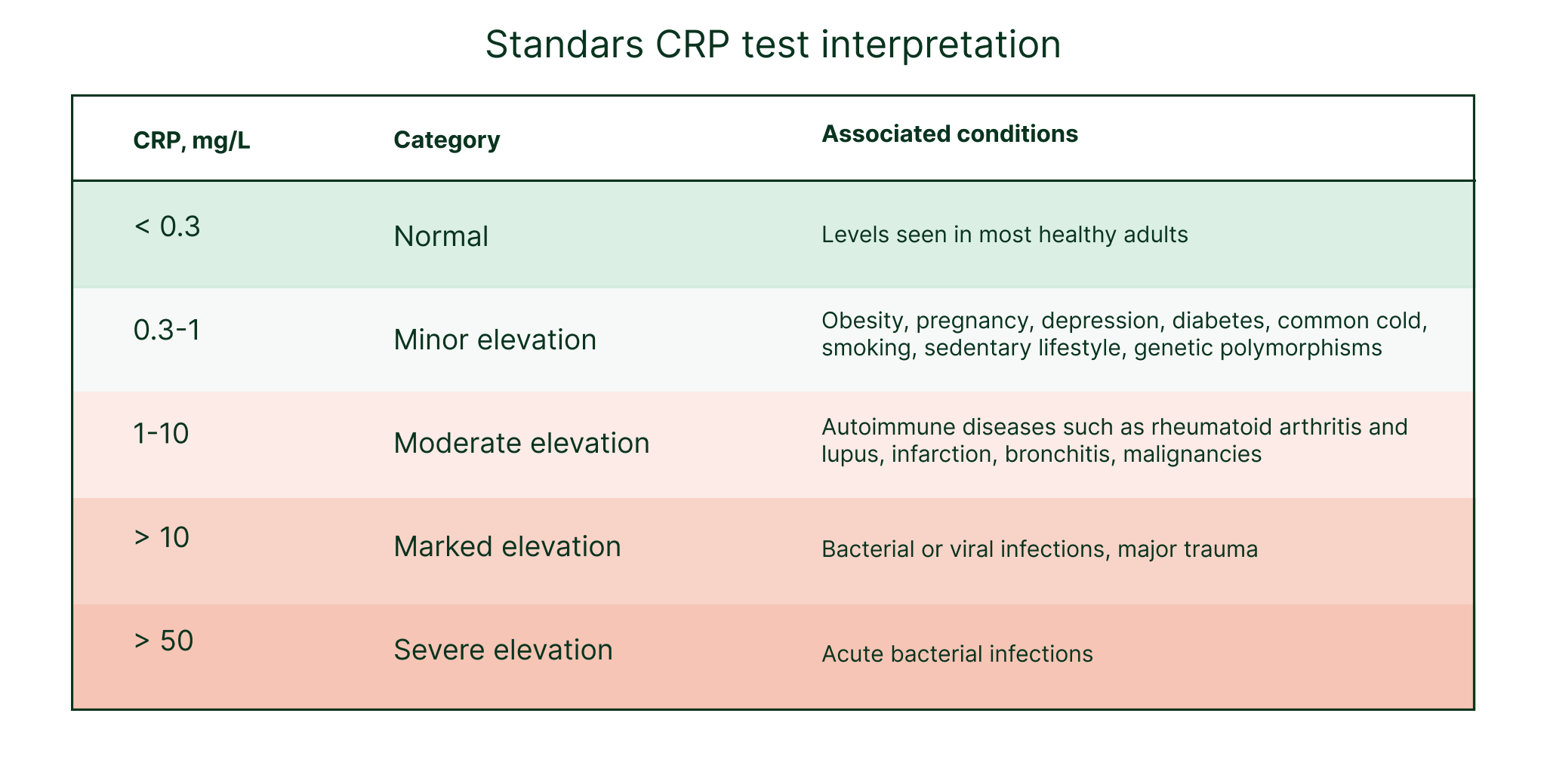High Sensitivity C-Reactive Protein (hsCRP): Explained
Learn about the high-sensitivity C-reactive protein (hsCRP) test and its significance in detecting inflammation and assessing heart disease risk.

In health diagnostics, inflammatory markers serve as crucial indicators of underlying health problems. Among these, one of the most widely studied and used biomarkers is high-sensitivity C-reactive protein (hsCRP).
What is CRP and Why is It Important?
C-reactive protein (CRP) is an acute-phase protein produced by the liver in response to inflammation.
When you're injured or fighting an infection, your body kicks into gear with what's called the acute-phase response. This is like a rapid defense system where immune cells release signaling molecules called cytokines. These cytokines stimulate the liver to produce CRP and other acute-phase proteins, which get released into your bloodstream to help tackle the problem.
The function of CRP can be divided into 2 steps:
- Recognition and binding of molecules present on the surface of pathogens
- Activation of various immune responses that help clear out the pathogens
CRP can activate multiple immune pathways:
- The complement pathway - a series of biochemical reactions that enhance the immune system's ability to eliminate pathogens and damaged cells
- Phagocytosis - a process in which immune cells engulf and digest pathogens or cellular debris

Conditions Linked to High CRP Levels
Levels of CRP increase whenever there is inflammation, no matter the source. Because of this, elevated CRP can be linked to various conditions—from acute infections to chronic diseases like cardiovascular disease and rheumatoid arthritis—and can also be seen in people with obesity.
Acute Infections
Both bacterial and viral infections can cause elevated CRP levels, however, bacterial infections usually cause a greater increase, sometimes up to 1000 fold. This increase happens quickly, sometimes before any symptoms occur, making it a good marker for detecting early infections.
CRP doesn’t only serve as an indicator of infection but also has a protective role against it. CRP can bind to phosphocholine - a molecule found in the cell wall of bacteria, and activate the complement pathway which helps to destroy the bacteria. It can also serve as an opsonin, marking the pathogens for destruction by your body’s immune cells.
Chronic Inflammatory diseases
Autoimmune diseases encompass a variety of disorders with diverse symptoms, all sharing a common feature - impairment in the immune system where the body attacks its own tissues.
Unlike the quick response seen in acute inflammation during infections, autoimmune diseases are marked by chronic low-grade inflammation. Consequently, the increase in CRP levels isn't as pronounced as in acute infections.
This constant overactivation of the immune system often manifests in elevated CRP levels in individuals with conditions such as rheumatoid arthritis, systemic lupus erythematosus, inflammatory bowel diseases, and others.
Cardiovascular Diseases
Numerous studies have demonstrated a strong association between elevated CRP levels and increased risk of cardiovascular events, including heart attack and stroke, making CRP a useful marker for cardiovascular risk assessment.
Similarly to autoimmune diseases, cardiovascular disease (CVD) is characterized by low-grade chronic inflammation, resulting in a less pronounced increase in CRP levels compared to infections. Since the standard CRP test cannot measure concentrations lower than 3 mg/L, specialized tests with greater sensitivity, such as high-sensitivity CRP (hsCRP), are used for CVD risk assessment.
HsCRP can be a useful biomarker for predicting CVD risk, especially when combined with traditional markers such as blood cholesterol, and clinical signs such as blood pressure. It can sometimes even be a good indicator in people with normal cholesterol levels. However, relying solely on hs-CRP is not sufficient for proper risk assessment, and it should be used in addition to other metrics.

CRP Testing and Interpretation
CRP tests are blood tests for inflammation routinely used in medical practice for assessing acute inflammation characteristic of infections, but also for detecting autoimmune conditions and assessing CVD risk.
Types of CRP tests
Different types of CRP tests vary in their measurement precision.
Standard CRP tests detect CRP levels greater than 3 mg/L and are primarily used for diagnosing acute infections or assessing acute inflammatory responses.
High-sensitivity CRP tests (hsCRP) offer greater specificity. These tests can detect concentrations as low as 0.1 mg/L and are commonly used in assessing CVD risk.
What Does The Test Measure?
Both standard CRP and hsCRP tests measure the concentration of CRP in the bloodstream. However, hsCRP tests can detect lower concentrations of CRP compared to standard ones and are used in assessing autoimmune disease and CVD risk.
When Should I Get This Test?
CRP tests are recommended in case you suspect you might have an infection, even if you don’t yet have any visible symptoms. On the other hand, hsCRP tests can also be used in assessing autoimmune conditions and the risk of CVD, due to their inflammatory nature.
The downside of CRP tests is that they can’t detect the source of inflammation, just the presence of it. However, if you’re on a specific treatment to reduce inflammation, CRP tests can be used to track if the treatment is working.
Understanding Results
Normal CRP levels in healthy individuals are typically considered to be less than 3 mg/L. Unhealthy lifestyle habits and underlying autoimmune or cardiovascular diseases may cause a slight elevation in CRP levels, up to around 10 mg/L. Levels above this range may indicate an acute infection, which could be viral or bacterial. However, CRP levels exceeding 50 mg/L are more indicative of acute bacterial infections.

Factors Affecting CRP Levels
Besides reflecting an underlying infection or a disease, CRP levels can also be elevated due to other factors:
Diet and Lifestyle
Unhealthy lifestyle habits, such as a poor diet, lack of physical activity, inadequate sleep, and high-stress levels, can all contribute to elevated CRP levels. While these factors may not have immediate effects, they quietly contribute to chronic inflammation over time, slowly paving a path to disease.
Genetics
Our genetic makeup can influence CRP levels in several ways. Firstly, specific genetic variants can lead to elevated baseline levels of CRP. Consequently, some individuals who appear healthy may exhibit high CRP levels, even without underlying inflammation.
Secondly, genetic factors can interact with environmental influences to modulate CRP levels differently among individuals. For example, while smoking might increase CRP in some individuals, it won’t in others due to genetic differences.
Medications and Medical Conditions
Infections and underlying diseases can elevate CRP levels due to their inflammatory nature. Infections typically result in greater CRP elevations compared to autoimmune or cardiovascular diseases. This is because infections trigger short-term acute inflammation, which is more intense than the low-grade chronic inflammation associated with autoimmune or cardiovascular diseases.
Depending on the condition, various medications are available for treating diseases and lowering CRP levels. For instance, statins are commonly prescribed for patients with CVD to lower levels of LDL or "bad" cholesterol. Statins can also lower levels of CRP, which is associated with reduced CVD risk, even when there is no evident reduction in levels of cholesterol. This underscores the potential of CRP as a marker beyond traditional clinical indicators.
Role in Predicting Future Health Issues
One of the most significant predictive roles of CRP lies in detecting future cardiovascular events and here we’re talking specifically about hsCRP tests. Although hsCRP has shown prognostic potential, its use in risk assessment is still limited and it is advised it rather be combined with additional CVD risk markers than analyzed on its own.
Strategies for Lowering CRP Levels
Because CRP can reflect inflammation caused by an unhealthy lifestyle, you can lower your CRP levels by adopting healthier habits such as:
- Eating a balanced diet rich in anti-inflammatory foods
- Engaging in regular exercise
- Quitting or reducing smoking and alcohol consumption
- Managing stress levels
Unfortunately, for certain conditions, lifestyle changes won’t be able to reverse the damage. With inflammatory diseases, such as autoimmune disorders and CVD, medications are necessary to manage the symptoms and help resolve the inflammation that is driving CRP levels.
Take Control Of Your Health With A GlycanAge Test
Although CRP tests can offer a glimpse into your health status, they are more reflective of acute inflammation which isn’t always a good indicator of health.
For a more accurate assessment of general health, chronic inflammation is a much better metric. However, measuring chronic inflammation with CRP tests is challenging due to CRP’s dynamic nature. Multiple measurements are needed to establish an average value, as CRP levels can fluctuate in response to any inflammation in the body.
GlycanAge is a cutting-edge test for measuring chronic inflammation. It analyzes glycans, complex carbohydrates attached to antibodies, that regulate the inflammatory status of your immune system.
One of the reasons GlycanAge is a better measure of chronic inflammation is the long half-life of the molecules it analyzes. Antibodies have a half-life of around 2 to 3 weeks, compared to CRP which has a half-life shorter than one day. This enables GlycanAge to reflect inflammation happening over a longer period of time.
Considering chronic inflammation is one of the main drivers of disease, GlycanAge can help you detect potential health risks. It is also very responsive and can detect changes in inflammation upon implementing interventions - whether these are lifestyle or medical ones.
This makes it a great tool if you want to track your progress or just want to get a better insight into your current health!
Start by taking a short health quiz or check out our prices and plans.

